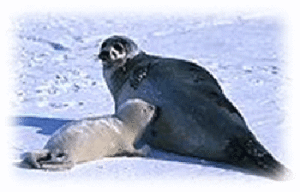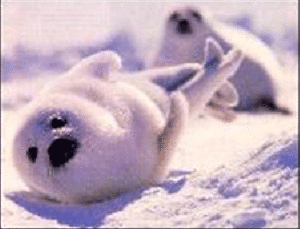by Anonymous
[The opinions expressed in these essays do not necessarily reflect the position of ARAUNY.]
As February winds down and we look forward to spring, a grim reality disguised as “tradition” comes forth. The annual slaughter of baby harp seals begins as soon as the pups start shedding their white coats and ice conditions permit. A white, pristine nursery where hundreds of thousands of seal mothers nurse their young becomes a horrifying, bloody killing field. Baby seals as young as 3 weeks to 3 months of age are clubbed, bludgeoned, and shot, then skinned for their fur. This barbaric ritual has been allowed to continue for centuries…and it’s time for it to end.

©IFAW
The sealers are off-season fishermen, mainly from Newfoundland who in today’s market yield less than 5% of their income from the hunt. Those who benefit the most are the ships’ captains and seal (skin) processors. The Carino Company is the largest processor in Canada and promotes products on their website such as seal fur and leather, seal oil, and seal meat “special order for agricultural purposes”. Seal meat used to be fed to ranched mink until the mink developed “foot pad necrosis” and failed to breed. Still, most of the seal carcasses are left to rot on the ice or drowned in the frigid waters.
The season for the commercial seal hunt of harp seals starts November 15th until May 15th, although sometimes it’s been extended into June. According to Wikipedia, “most sealing occurs in late March in the Gulf of St. Lawrence and during the first or second week of April off Newfoundland in an area known as the Front. This peak spring period is generally referred to as The Canadian Seal Hunt.” In the Gulf phase, sealers club the pups using a hakapik, a long wooden stick with a curved metal spike at the end for dragging the dead animal. Sealers must work fast to kill as many seals as they can in a short period of time, because they compete with each other for quotas. Each region is assigned a total quota, so the sealers work as quickly as they can to reach the quota before the hunting is shut down for that area.

©IFAW
Because of video and eyewitness observations which showed seals being skinned alive, the DFO (Department of Fisheries & Oceans) now requires the sealers to palpate (strike) the seal’s head with a club or rifle to assess if the skull has been fatally crushed before skinning. Sealers are also required to administer a “blinking reflex” test to confirm that the seal is dead before going on to another. Then the sealer is required to exsanguinate (bleed) the seal underneath the flippers for one full minute before skinning. Given the harsh environment in which the seal hunt takes place, these extra steps required to determine if the seal is verifiably dead before being skinned is next to impossible. Gale winds, freezing rain, dense fog, and now with climate change, unsteady and melting ice, along with the intense speed and pressure to kill as many seals as possible make it very difficult to conduct these tests. In fact, independent veterinarians as well as observers from the Humane Society International (HSI) and International Fund for Animal Welfare (IFAW) have documented that the cruelty of the seal hunt is escalating. Regulations are repeatedly violated and Fisheries officers, residents of the same regions as the sealers, are reluctant to enforce any law pertaining to the animals’ welfare. Many times the palpation and corneal reflex tests do not mean the seal in unconscious; while being sliced open or skinned, seals have been observed to demonstrate pain.
In the second phase of the hunt, in the waters of The Front northeast of Newfoundland, the seals are more mobile and more able to swim, thus the weapon of choice is the shotgun. But again, under the harsh weather conditions of gale winds, dense fog, freezing rain, and at times ocean swells, a clean shot (to the seal’s head so as not to damage the pelt) is virtually impossible. Wounded seals can escape into the water where they most likely will drown. If the seal is captured, the sealer will oftentimes hook the seal in its mouth, dragging it into the vessel. Particularly heart-breaking is that the seals, who are so vulnerable with virtually no defense mechanisms, try to defend themselves or their young from the hunters.
The Canadian commercial seal hunt is the largest slaughter of marine mammals in the world. The number of animals killed each year is staggering: In the year 2014 the TAC (Total Allowable Catch or quota) was 400,000 harp seals; the actual number killed was 54,661 (not including those killed in the Gulf). In 2013 the TAC was again 400,000; actual number killed was 90,318. In 2008 the TAC was 275,000; actual killed was 217,857. (Source: IFAW) These numbers don’t include quotas for hooded or grey seals, nor do they include the number of seals shot or struck and not retrieved; the Canadian government estimates that figure could be 5% of seals landed. Scientists are concerned the continuation of the commercial seal hunt will mean extinction for the harp seal. Not only are the quotas incredibly excessive but some believe the harp seal is threatened even more by climate change, which is gradually melting the ice floes the seals need to survive. Harp seals are born and live on the ice—if the ice goes so do the seals. In addition, pollution caused by chemicals, metals, fertilizers and plastics, plus acidification of the ocean pose an enormous threat not only to the seals but to all sea life.
Why does Canada still allow the slaughter of baby seals? There are a number of answers to this question. In past years, baby seals were killed mainly for their beautiful white fur until world-wide outcry and an international seafood boycott led to a ban on the killing of seals younger than two weeks of age (1984). In the early 1990’s the Canadian cod fisheries collapsed, putting 40,000 fishermen out of work. The DFO claimed the harp seals were a large part of the problem, when in fact the harp seal’s diet consists of only 3% cod; they are opportunistic eaters, consuming a variety of fish and even predators of cod. The real reason for the collapse can be attributed to the wanton mismanagement of the fisheries by the DFO, allowing foreign trawlers to plunder the waters off the east coast of Canada. The DFO is now shifting blame to the grey seals and “The Department continues to study the interaction between grey seals in Quebec and Atlantic Canada and this information will be used to inform management of both the seal harvest and the cod fishery” (source). I think we all know what management means.
What can we do to end the Canadian Seal Hunt? In spite of the diminishing market for seal products throughout the world, particularly the import ban instituted by the European Union in 2009 and upheld this year, Canada adamantly defends the seal hunt while spending millions of tax dollars subsidizing it via loans to seal processors, lobbying oversees to open or renew markets, and promoting seal meat and oil. Polls have consistently shown that most Canadians, even those residing in Newfoundland, are opposed to the hunt. Rather than spending tax money to support a dying industry, the Humane Society International and other animal welfare groups, and some sealers and M.P.’s propose a federal buyout of sealing licenses along with investment in community-based alternatives, as was implemented some years ago when Canada called a moratorium on whaling. On HSI’s website is a form for Canadian citizens to fill out requesting Prime Minister Stephen Harper to accept the buyout.
In the U.S., many restaurants and chefs have joined the renewed Canadian seafood boycott. Most of the seafood caught in Canada is exported to the U.S. The country of origin is required to be labeled on all seafood, so if you or a friend consume seafood, ask what the country of origin is and if it’s from Canada—don’t buy it. Here’s the link to sign the pledge to not buy Canadian seafood for individuals and restaurants.
Please, spread the word—and learn more about the Canadian seal slaughter and what more can be done to stop it once and for all.
Sources:
- www.harpseals.org
- www.hsi.org
- www.hsus.org/protectseals
- www.seashepherd.org/seals
- http://www.hsi.org/assets/pdfs/inherently_inhumane_richardson_seals.pdf
Photos: Mother and baby seal: Copyright IFAW; sealer striking baby seal: liberation bc; white harpseals: harpseals.org (photographer unknown).


